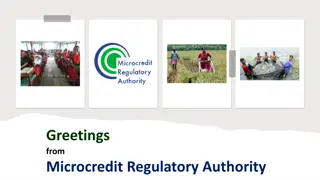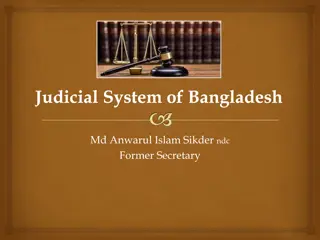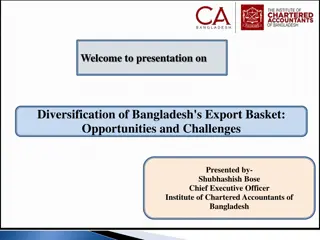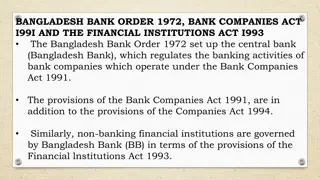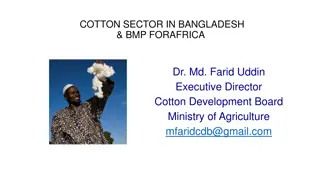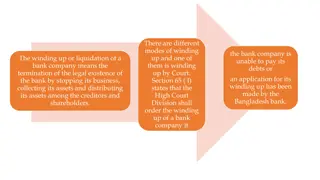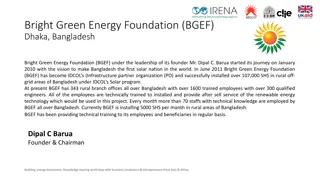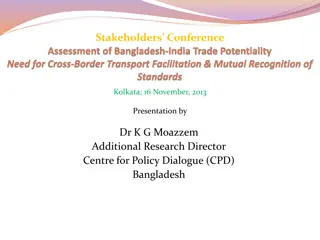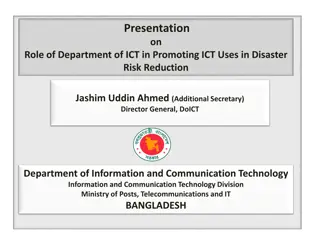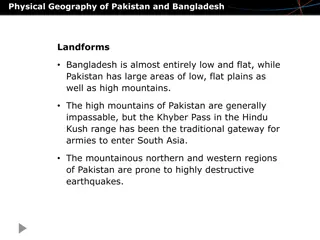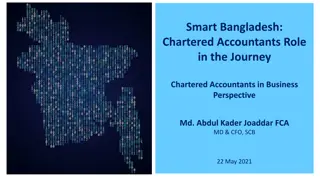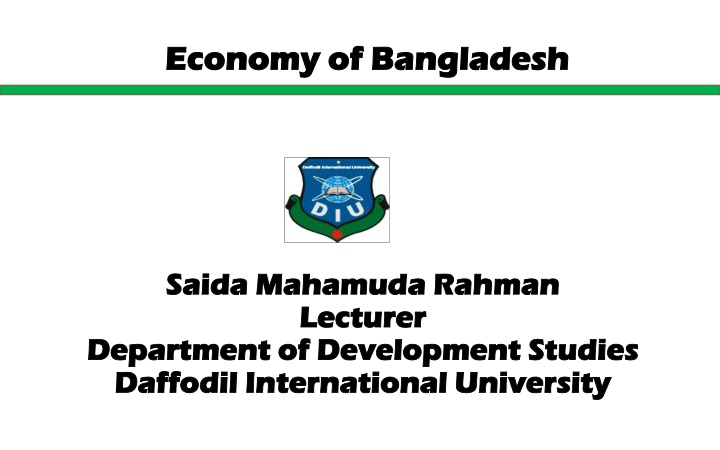
Insights into Bangladesh's Economy: Historical Background, Nature, and Development Planning
Explore the historical evolution, nature, and development planning of Bangladesh's economy, from nationalization policies to the emphasis on foreign investment and development sectors. Learn about the country's mixed economy, foreign relations, and approaches for growth.
Download Presentation

Please find below an Image/Link to download the presentation.
The content on the website is provided AS IS for your information and personal use only. It may not be sold, licensed, or shared on other websites without obtaining consent from the author. If you encounter any issues during the download, it is possible that the publisher has removed the file from their server.
You are allowed to download the files provided on this website for personal or commercial use, subject to the condition that they are used lawfully. All files are the property of their respective owners.
The content on the website is provided AS IS for your information and personal use only. It may not be sold, licensed, or shared on other websites without obtaining consent from the author.
E N D
Presentation Transcript
Economy of Bangladesh Economy of Bangladesh Saida Saida Mahamuda Mahamuda Rahman Lecturer Lecturer Department Department of Development Studies of Development Studies Daffodil International University Daffodil International University Rahman
Objectives of this Class Learning more about the historical background of our economy. To examine the Economical nature of Bangladesh. To know about various development planning in BD: vision 2021, SDGs, 2041, and Delta Plan-2021 Understand the concept Gig economy and Blu economy To increase our foreign investment so that, our economical development can grow rapidly. To gain more knowledge about various economical developing sector. To know about the vision 2021 expectations and SDGs To identify some common problems in economic sector in Bangladesh & how to get rid of this problems.
Historical Background of the Economy of BD Sheikh Mujib era: Between 1972 to 1975, the government of Bangladesh took nationalization policy. That means nationalized economy or, state own economy. Ziaur Rahman era: Between 1976 to 1981, nationalized economy to denationalized economy Ershad era: Between 1982 to 1990, he focused on denationalized economy, more specially development of Private sector (Establishment of Privatization Board in 1989). Begum Khaleda Zia era: Between 1991 to 1996 and between 2001 to 2006, More importance was given to trade, and a roving trade representative of the country was appointed. In the economic interest of the nation, the policymakers of Bangladesh would come closer to India for regional and bilateral economic cooperation. Sheikh Hasina era: Between 1996 to 2001, and 2008-till, focused on Foreign Investment; International Migration and Remittances; and Implementation of Mega Projects. She explained the concept of "Bay of Bengal Industrial Growth Belt (BIG-B)", the improvement of investment environment and regional connectivity.
Nature of the Economy of BD It is a mixed economy (Public and Private) Patronizing money or free market economy Making open border relationship with rest of the world Developing the concept of privatization Highly depending on national and international loan Depended on development actors, organizations and countries Emphasizing on foreign direct investment (FDI) Depended on Foreign Remittance and Labor market Majority export income come from RMG Industry Public-Private partnership newly introduced
Approaches to Development Planning in BD Approaches to Development Planning in BD Development planning provides the road map for accelerated growth and lays down broad approaches for eradication of poverty, inequality, and human deprivation. Bangladesh's economy has been an orphan without a long-term perspective plan, more like a vessel without a compass. Marking vision 2021 a reality, is a strategic articulation of the development vision, mission, and goals of the Bangladesh government. To make the Vision 2021 a reality, the Perspective Plan of Bangladesh 2010-2021 was adopted. Specific strategies and the task of implementation will be articulated through the two five-year plan: Sixth Five Year Plan (2011-2015) and the Seventh Five Year Plan (2016-2020) which are further broken down as Annual Development Plans. Vision 2021 Vision 2021 Perspective Plan (2010-2021) Five Year Plans (6th and 7th) Annual Development Plan
Annual average growth (%) Plan Period Target Actual First five year plan (FY1973-FY1978) 5.5 4.0 Two year plan (FY1978-FY1980) 5.6 3.5 Second five year plan (FY1980-FY1985) 5.4 3.8 Third five year plan (FY1985-FY1990) 5.4 3.8 Fourth five year plan (FY1990-FY1995) 5.0 4.2 Fifth five year plan (FY1997-FY2002) 7.0 5.1
Vision 2021 Expectations Vision 2021 Expectations The expectations are that by 2021, the war against poverty will have been won, the country will have crossed the middle income threshold, with the basic needs of the population ensured and their basic rights respected, when everyone is adequately fed, clothed and housed, and have access to health care. And all this is achieved on a sustainable basis without damaging the environment. Furthermore, this progress will be ensured in an environment where every citizen has the opportunity fully and positively to contribute to the economy and society and equitably share the benefits from progresses achieved.
Sustainable Development Goals (SDGs) Sustainable Development Goals (SDGs)
Vision 2041 Expectations Vision 2041 Expectations The government's Vision 2041, which is a continuation of Vision 2021, aims to carry the development journey of Bangladesh that Bangabandhu had dreamed of to end absolute poverty and to graduate into a higher middle- income status by 2031 and a developed country by 2041. The per capita income will be US$ 5500 by 2031 while it will be US$ 16000 in 2041.
Bangladesh Delta Plan 2100 Bangladesh Delta Plan 2100 The BDP 2100 seeks to integrate the medium to long term aspirations of Bangladesh to achieve upper middle income (UMIC) status and eliminate extreme poverty by 2030 and being a prosperous country beyond 2041 with the longer term challenge of sustainable management of water, ecology, environment and land resources in the context of their interaction with natural disasters and climate change.
Bangladesh Delta Plan 2100 Bangladesh Delta Plan 2100
Budgeting in Bangladesh Budgeting in Bangladesh Budget is an itemized estimate of expected income and expense for a given period in the future. A government budget is a government document presenting the government's proposed revenues and spending for a financial year. Major institutions in budget formulation & implementations in BD are: Ministry of Finance 1. Finance Division: overall & expenditure 2. Internal Resource Division- domestic 3. Economic Relations Division- external Ministry of Planning- FYP, ADP Planning Commission- Coordinating & finalization of investment plans IMED - Implementation Monitoring and Evaluation Division Line Ministries- Scrutinizing demand Directorate/Offices- Organizing demand
Preparation of Revenue Budget Preparation of Revenue Budget The revenuebudget pays for the normal functioning of the government and is intended to be fully financed from domestically generated sources. The Ministry of finance and planning is responsible for the preparation of revenue budget in cooperation with different ministries/divisions and account offices. The steps of the preparation of revenue budget are- a) Distribution of forms It means the process of distribution of budget forms. It includes Estimating officer s forms and controlling officer s forms. b) Submission of estimates to the Finance division It means the process by which the accountant general submits the final estimates of receipt and expenditure to the finance division. c) Finalization of estimates The budget wing of the finance division examines the estimate report from the controlling officers and accountant general. Then it makes the final best judgment about the budget. d) Schedule of new expenditure It means the detection of some new expenditure for the upcoming year. Though it is a part of revenue budget, sometimes it can be presented desperately.
Role of Key Financial Organizations There are three key financial bodies which determine and execute the development budget of Bangladesh. These are: Planning Commission National Economic Council (NEC) Executive Committee of the National Economic Council (ECNEC)
Role of Key Financial Organizations (ECNEC) According to available records, the composition and functions of ECNEC are laid down in the Cabinet Division Resolution in 1982. However, the said resolution supersedes all previous orders in this respect. Composition of ECNEC Prime Minister - Chairperson Finance Minister - Alternate Chairperson Planning Minister Vice Chairperson All members of cabinet work as a member of ECNEC.
Functions of the ECNEC Functions of the ECNEC Consider and approve all project concept papers; Consider and approve development projects recommended by Special Project Evaluation Committee costing above taka 5 crore; Consider and approve investment projects in the private sector costing above taka 15 crore; Review the progress of implementation of development project and monitor economic situation and economic activities of the country and review policies; Consider proposals for investment companies as private or joint ventures or with foreign participation;
Functions of the ECNEC Functions of the ECNEC Promote the economic situation and review over-all performance of the economy and related policy issues; Consider financial performance of statutory corporations and specially their financial results; Consider rates, fees and prices of public utility services or products of public enterprises. Consider measures relating to foreign aid, expansion of commerce and determine targets for the Bangladesh missions abroad in respect of export of manpower including review of progress in these areas.
Recent Economic Trends in BD: on Right Track? Recent Economic Trends in BD: on Right Track? The country's foreign exchange reserve is reported to have hit a new high with a record of $33 billion. The central bank has targeted average inflation at 6.5 per cent for fiscal year 2015. The rate was 7.4 per cent in the previous fiscal. Empirical evidences show that 6-7 per cent inflation goes well with economic growth. Bangladesh is expected to receive $15.05 billion in 2014 which is enough to retain the last year s eighth position among top ten remittance-earning countries. Investment is sluggish due to poor investment climate. Private sector credit growth went down to a 13-year low of 10.4 percent in February 14. But things started taking a U-turn since then and the growth rose to 12.3 percent in June. Garment still accounts for 80% of the export basket, despite domestic optimism about the pharmaceutical sector, which makes up only 0.5 percent. So Bangladesh needs to diversify its export basket. Sources: 1 Abdul Bayes, Positive Trends in the Economy, Economic Observer, August 2014 2 The Daily Star, Thursday, October 09, September 26, 2014
Recent Economic Trends in BD: on Right Track? Recent Economic Trends in BD: on Right Track? Bangladesh's economy has grown 8.13 per cent this fiscal year, the highest in its history, Finance Minister AHM Mustafa Kamal said while releasing a provisional estimate. FDI flows to Bangladesh rose by 68% to a record level of $3.6 billion (UNCTAD, 2019). Source: https://www.thedailystar.net/business/economy/bangladesh-gdp-growth-rate-2018-19-8.13-per-cent-1717291 https://www.dhakatribune.com/bangladesh/foreign-affairs/2019/06/14/bangladesh-sees-record-growth-in-fdi-trend-likely-to-continue
Common Problems in Economic Sector in BD Common Problems in Economic Sector in BD Lack of Knowledge and Skills Not ensure financial freedom Improper combination & coordination Lack of skilled and sound manpower Improper role of various organizations Improper role of press and media Lack experience in foreign ministry Less experience of foreign diplomats Inequality Presence of black money Corruption practices Political Instability Inadequate Government and Bureaucratic Structures Aid Dependence Over growth of Population Land Scarcity Natural Disaster Increase rate of Unemployment Patronize Bank Defaulters culture Lack of Knowledge and Skills Not ensure Financial Freedom
Some Measures for Economic Development of BD Some Measures for Economic Development of BD Build National & International Cooperation. Increase Remittances & Intellectual Investment. Need Market Expansion. Increase promotion of Trade Market. Increase labor force in the Industrial sector. Ensure proper uses of the Budget in every sector. Utilize the Demographic Dividend Should build up National Integration among political parties. Ensure Sustainable Development Stop Corruption and Mismanagement Need Good Governance and rule of law Create Employment by establishing new industry Emphasize on Foreign Direct Investment, Mega Projects Give incentive for the private sectors and entrepreneurs Utilize the youth generation in ICT sector
Chapter related Questions Chapter related Questions What was the historical background of the economy of Bangladesh? Economy of Bangladesh is mixed one -explain this statement. Discuss the nature of the economy of Bangladesh. What is budget? Discuss the process of making various budgets. What is SDG? Mention the key targets of it. What is Planning Commission? Narrate the history and functions of it. What is ECNEC? Write down the composition of ECNEC. Discuss the prime functions of it. Discuss the recent economic development trend of Bangladesh. What problems and challenges have in economic sector of Bangladesh and what needs are very much crucial for meeting these problems and challenges?

